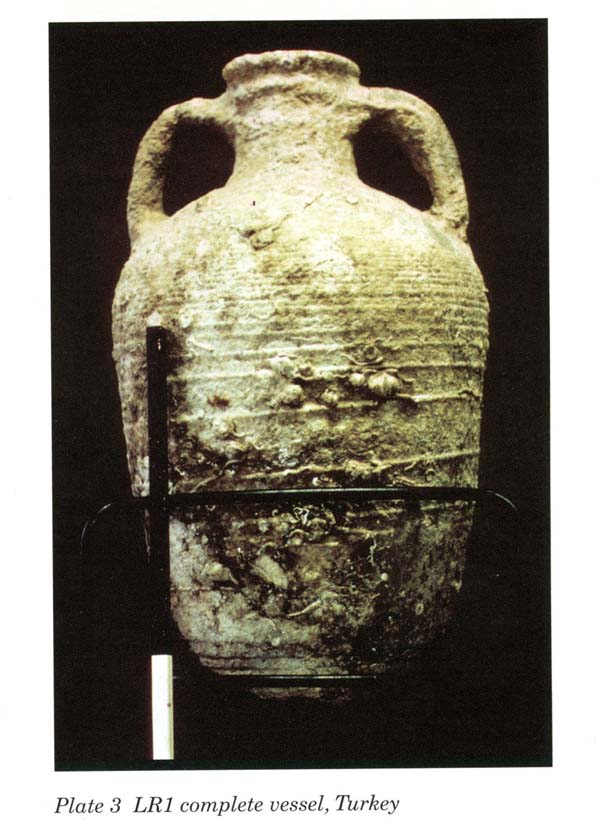Late Roman
Late Roman Amphora Sherds from Co. Waterford
Unexpected discovery of Late Roman amphora sherds amongst the excavated material in the crypt of the National Museum of Ireland.
By Sharon Weadick
Previously unidentified sherds of a Late Roman amphora from an excavation at Killeenagh church, Ballygarran, Co. Waterford were catalogued by the Inventory Team. This rare find increases the evidence in the early medieval period for greater contact and trading links between Ireland, an island on the periphery, and the Roman world.
The Museum register entry for this material reads:
“Miscellaneous finds from a church site at Ballygarran, County Waterford. Investigated as Excavation No. XLIV of the Archaeological Excavations carried out as part of the Relief of Unemployment Scheme and administered by the Office of Public Works. Excavated by Mr M J Bowman John's Hill, Waterford. For List of objects see file.”
What exactly was found?
Six sherds of Late Roman type amphora (Bii ware) were excavated - one handle sherd and five body sherds. This pottery would have come from the eastern Mediterranean region, probably Syria or Cyprus.
What does the object look like?
The fabric of the pottery is generally pink, red, buff or orange with white grit inclusions. Complete it would have resembled the amphora in Figure 2.

Figure 2: Complete vessel from Turkey
Bii ware – a wider context
Bii ware dates to the late 5th and early 6th centuries and was used to contain and/or transport wine or olive oil. In Ireland Bii ware has been found on both secular and ecclesiastical sites of high status - at the stone fort at Garranes, Co. Cork and the ecclesiastical site at Reask, Co. Kerry. In return for the olive oil and wine Irish traders would have provided foodstuffs, hides and copper.
The excavation of the church
The excavation was carried out under the direction of a local antiquarian, Mr Bowman, in 1940. Unfortunately the excavation was never published, but a preliminary report is on file in the archives of the National Museum.
Why is the discovery so important?
Traditionally it has been considered rare to find Roman material in excavated contexts in Ireland but this is now being re-evaluated. In 1959 Bii ware pottery was recorded at only 2 sites in Ireland (Kelly, 2009, 15). However, as archaeologists become more familiar with Roman pottery types this number is now increasing.
This new evidence elevates the status of the ecclesiastical site at Ballygarran as the community living there at the time were clearly wealthy enough to purchase imported goods from the eastern Mediterranean.
It also provides valuable dating evidence and proves that the site was occupied during the 5th and 6th centuries.
Bii ware and imported pottery found in funerary contexts.
Recent research shows that there appears to be a deliberate deposition of Bii ware and E ware sherds in funerary contexts, whereby the pottery would have functioned as a votive offering (Doyle, 2009, 32-34). As there were at least two burials discovered by Bowman in the course of the excavation at Ballygarran, it is possible that the Bii and E ware sherds found were votive deposits. Unfortunately, the contextual information of these sherds cannot be determined and it is currently not possible to say if they were deposited in or near one of these burials.
Learn more…
This object is not on public display as it is part of the museum’s reserve collections. If you would like to learn more about ceramics in the classical world you can see similar artefacts on display in the Ceramics and Glass from Ancient Cyprus and Life and Death in the Roman World exhibitions on the first floor in the National Museum of Ireland – Archaeology on Kildare Street, Dublin.
You can also read more about imported wares during this period in the following:
Kelly, A. (2009) Report on the Archaeological excavation of Collierstown 1, Co. Meath, Appendix 10a, 1-25 – Download the full PDF file here (13MB, pdf)
Kelly, A. (2010) The discovery of Phocaean Red Slip Ware (PRSW) Form 3 and Bii (LR1 amphorae) on sites in Ireland – an analysis within a broader context, PRIA, Section C 110, 35-88.
Doyle, I.W. (2009) Mediterranean and Frankish pottery imports in early medieval Ireland, The Journal of Irish Archaeology, 18, 17-62.
*With thanks to Ian Doyle and Raghnall Ó Floinn for identifying the pottery types.
Location:
Late Roman Amphora Sherds from Co. Waterford is located at:
In Storage
Previous artefact:
Late Neolithic Flint Daggers from Denmark
Next artefact:
Lead-Bearing Minerals from Glendalough
